
.png)

.png)
.png)


-
.png) 0086-757-85407388
0086-757-85407388 -

-
 terrychen@wintoly.com
terrychen@wintoly.com


.png)

.png)
.png)


.png)



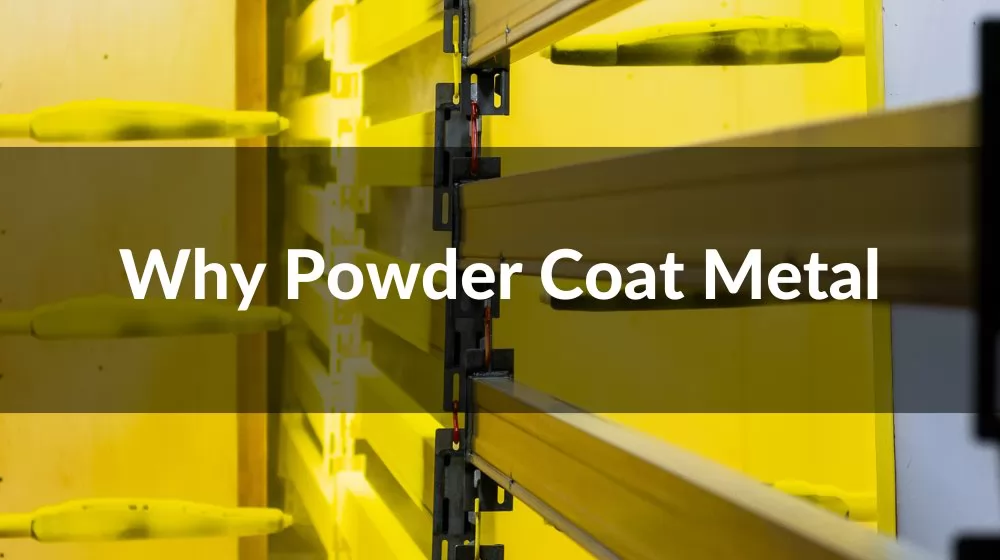
In the world of metal finishes, powder coating has emerged as a revolutionary technique, transforming everything from aesthetics to durability. From everyday items to industrial machinery, the application of powder coat metal finishes promises longevity, cost-effectiveness, and an unmatched visual appeal. Whether you're contemplating if powder-coated steel rusts or pondering the benefits of powder coating aluminum and steel, this comprehensive guide dives deep into the transformative power of powder coating. Discover why businesses globally are embracing this game-changing finish.
More Reading: What Materials Can Be Powder Coated?
Powder coating is not just a buzzword in the industrial and manufacturing sector; it's a revolutionized process that adds durability and aesthetic appeal to metals. For businesses looking to add a touch of resilience and a splash of color to their metal products, understanding powder coating is crucial. Let's delve deeper.
Powder coating is a dry finishing process that has become increasingly popular since its introduction in North America in the 1960s. Representing over 15% of the total industrial finishing market, its primary advantage is its ability to create a hard, durable finish on metals, which is less likely to scratch, chip, fade, or wear than other finishes. The process involves applying a powdered paint substance—often a mixture of finely ground particles of pigment and resin—to metal surfaces. Once the powder is applied, the object is placed in an oven where it's baked until the powder melts, flows, and forms a hard, protective coating.
The science of powder coating is both fascinating and robust. It revolves around the principle of electrostatics. When the powder is sprayed onto the surface of the metal, it's given a negative electric charge. The metal object, on the other hand, is grounded, creating a positive electric charge. This difference in charges causes the powder particles to be irresistibly attracted to the metal surface, adhering to it seamlessly. Once this is achieved, the curing process in the oven allows the particles to melt and fuse into a solid coat. This reaction is not just a mere melting but a chemical cross-linking process, turning it into a dense layer of protection and color.
In a realm of countless finishing techniques, powder coating stands tall, admired both for its practicality and its aesthetic charm. But beyond the technical aspects, why has powder coating emerged as a preferred choice for many? From giving metals a facelift to ensuring uniform application, the allure of powder coating is multifaceted. Let's delve deeper into its aesthetic transformation and the consistency it offers.
Raw metal, while strong and durable, often lacks the character and vibrancy desired for various applications. This is where the magic of powder coating comes into play. It's akin to giving metal a colorful personality. This technique can turn a plain metal surface into a vibrant work of art, bursting with colors ranging from deep reds to shimmering golds or even cool blues. Different finishes, be it glossy, matte, or textured, add another dimension to this art form. For instance, a matte finish might exude elegance and sophistication, while a textured surface can introduce tactile intrigue, mimicking materials like wood, stone, or even leather. Moreover, the UV-resistance of powder-coated surfaces ensures that these colors don't just shine bright but stay bright, resisting the fading effects of sunlight over time.
And it doesn't end there. With advancements in technology, powder coating now offers finishes that can replicate the appearance of natural materials, including the intricate grains of wood or the ruggedness of stone. Such versatility allows designers and manufacturers to achieve a harmonious blend of strength (from metal) and aesthetics (from the coating), catering to modern design preferences.
In the finishing world, consistency is paramount. It's not just about how vibrant or intricate a finish is; it's about achieving that finish uniformly, every single time. Traditional painting techniques, while effective, often come with their set of challenges — brush strokes can be uneven, drips can mar the surface, and achieving a consistent thickness can be a Herculean task. Enter powder coating. Thanks to its electrostatic application process, many of these challenges become non-issues. The charged powder particles ensure they cling to every nook and cranny of the metal surface, offering a seamless, even finish.
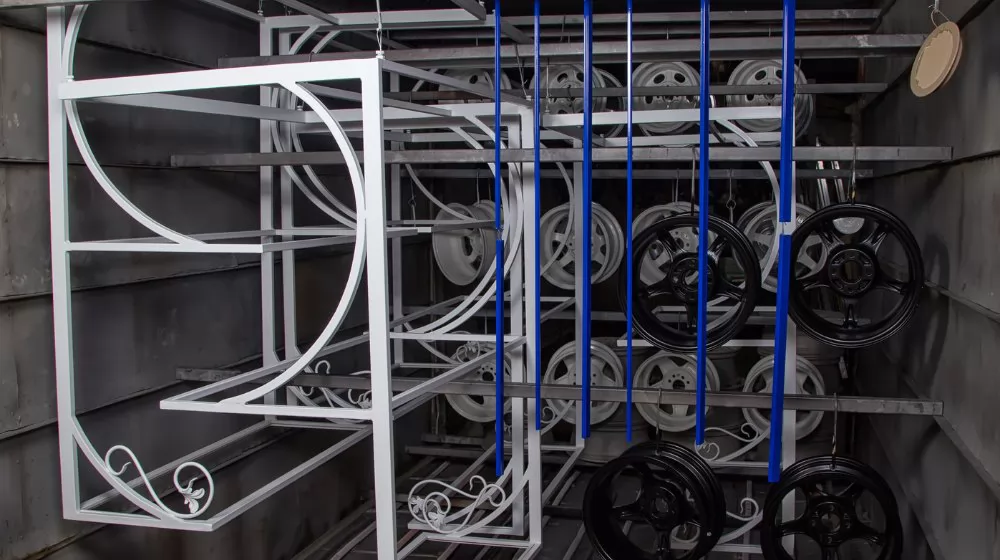
When selecting a finishing method for metal products, durability is often at the forefront of considerations. After all, what's the point of a visually stunning finish if it doesn't last? Powder coating not only brings aesthetic charm but also provides a fortress-like shield to metals, enhancing their lifespan and resistance to external threats. Let's delve into the remarkable durability attributes of powder coating.
Metal, despite its strength, has an Achilles' heel: its vulnerability to rust and corrosion. These processes can deteriorate metal, impacting both its appearance and structural integrity. Powder coating comes to the rescue, acting like a protective guardian against these corrosive forces. The sealed, continuous finish of powder coating leaves no room for moisture, air, or corrosive elements to seep through and reach the metal substrate. In contrast to traditional liquid paints, which can sometimes have microscopic gaps or inconsistencies, powder coating provides a more robust and comprehensive barrier.
This protection is even more vital in challenging environments where metals are exposed to salt, chemicals, or high humidity. For instance, metals in coastal regions or industrial settings face a higher risk of corrosion due to the salty air or chemical exposure. Powder coating provides a steadfast defense, ensuring metals in such settings retain their strength and appearance longer than they would with other finishes.
Environmental factors, ranging from UV rays to pollution, can be detrimental to metal finishes. Over time, these factors can cause discoloration, chalking, or a loss of gloss. Powder coating, however, is equipped to stand its ground against these challenges. Its formulation often includes UV-resistant compounds, ensuring that the vibrant colors and glossy finishes remain unscathed even after prolonged exposure to sunlight.
But it's not just about the sun. Powder-coated surfaces are also resilient against pollutants and airborne contaminants. In urban settings, where metals are frequently exposed to vehicle exhaust, smoke, and industrial emissions, this resistance is invaluable. The smooth, non-porous surface of powder-coated metals ensures that dirt and pollutants don't easily adhere, making maintenance easier and less frequent. Furthermore, it resists chipping and abrasion, ensuring that the protective barrier remains uncompromised even in the face of physical wear and tear. In essence, powder coating acts as a vigilant sentinel, guarding metals against the multifaceted challenges posed by our environment.
While the initial appeal of powder coating often revolves around its aesthetic and durability advantages, the economical benefits it offers cannot be overlooked. From long-term cost savings to a notable reduction in maintenance expenses, powder coating serves as both a visual and financial boon for businesses. Let's break down the tangible economic advantages it brings to the table.
At first glance, the initial cost of powder coating might seem comparable to or slightly higher than traditional paint finishes. However, when viewed from a holistic, long-term perspective, the scales tip heavily in favor of powder coating. Why? The answer lies in its exceptional durability. A powder-coated surface, with its resistance to rust, corrosion, chipping, and UV-related fading, stands the test of time. This means fewer reapplications and touch-ups over the years.
Moreover, the application process itself is more efficient. There's less wastage since oversprayed powder can be collected and reused. Coupled with the fact that powder coating often requires a single application versus multiple layers with liquid paints, the labor and material costs get further optimized. Over the lifespan of a product, these savings accumulate, presenting a compelling cost benefit for businesses and consumers alike.
Maintenance costs, often considered a necessary evil, can take a toll on a company's bottom line. With traditional finishes, routine maintenance, touch-ups, and refinishing are par for the course. However, the robust nature of powder coating slashes these maintenance demands.
Its resilient finish means fewer scratches, chips, or faded areas that demand attention. This is particularly beneficial for products or installations in high-traffic or high-use areas where wear and tear are inevitable. When you factor in the cost of labor, materials, and potential downtime for these touch-ups, the savings become significant. Plus, with less frequent maintenance, the product or installation remains in pristine condition for longer, ensuring satisfied end-users and fewer warranty claims.
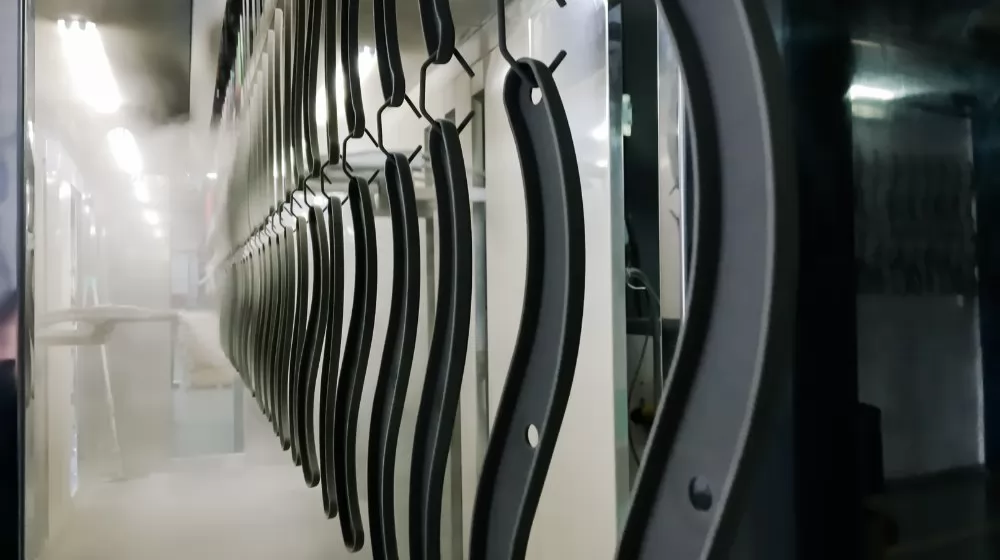
In our era of heightened environmental awareness, businesses are continuously seeking sustainable and eco-friendly solutions. It's not just about compliance, but also about corporate responsibility and the appeal to environmentally-conscious consumers. Enter powder coating — a finish that isn't just durable and attractive, but also remarkably green. Here's how powder coating is leading the way in environmental stewardship.
Traditional liquid paints come with a significant level of waste. Overspray often can't be reclaimed, leading to both material wastage and the potential contamination of surrounding environments. Powder coating, on the other hand, is a dry finishing process. Any oversprayed powder can be collected and reused, minimizing material wastage. This efficiency translates to a reduced need for raw materials, thus diminishing the environmental footprint of the manufacturing process.
Additionally, since powder coating typically requires fewer applications than liquid paints, there's a decrease in energy consumption. Fewer curing sessions in ovens and less processing time further bolster its environmental credentials.
One of the most significant environmental pitfalls of many traditional paints is the emission of volatile organic compounds (VOCs). These compounds contribute to smog, ozone depletion, and are detrimental to indoor air quality. Furthermore, many liquid paints contain solvents, which evaporate into the atmosphere during the drying process, compounding the environmental impact.
Powder coatings, however, contain no solvents and emit negligible, if any, VOCs. This makes the powder coating process considerably more environmentally friendly, reducing its impact on air quality and the broader environment. It also ensures safer working conditions, as workers are less exposed to harmful chemicals.
One of the standout qualities of powder coating is its incredible versatility. Whether you're dealing with diverse metal substrates or aiming for a specific aesthetic finish, powder coating rises to the challenge. This adaptability not only broadens the scope of applications but also provides manufacturers and consumers with an array of choices to suit their precise needs. Let's unpack this versatility further.
While many associate powder coating predominantly with steel or aluminum, the reality is far more expansive. Powder coating is adaptable and can be applied to a variety of metals, ensuring protection and enhanced aesthetics. This includes, but is not limited to, brass, copper, bronze, and even stainless steel. The process ensures that metals like aluminum don't oxidize, while steel gets an added layer of protection against rust and corrosion.
This suitability extends to "powdercoating steel" and "powdercoating aluminum", as highlighted. The pre-treatment process for each metal type ensures optimal adhesion of the powder, maximizing durability and finish quality. As such, manufacturers can confidently choose powder coating for a broad range of projects without concerns about compatibility.
Beyond its functional attributes, powder coating is an artist's palette when it comes to aesthetics. Gone are the days when choices were limited to a handful of standard colors. Today, the spectrum of available hues is vast, ranging from subtle mattes to vibrant glossies, and everything in between.
Moreover, the range isn't limited to color alone. Textures and finishes have expanded to include matte, satin, gloss, metallic, and even special effects like veins, hammertones, and glitters. This gives designers and manufacturers an incredible toolkit to match brand aesthetics, create signature products, or simply ensure that the coated object seamlessly fits into its intended environment.
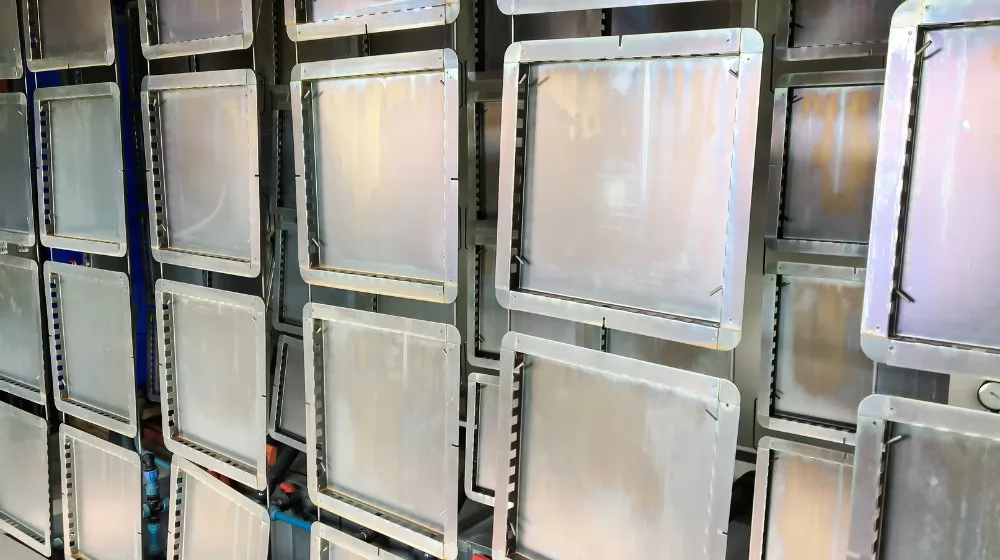
Powder coating is not just an aesthetic treatment; it's a rigorous process that augments the performance of metals. This enhancement can be observed across various fronts, including electrical insulation, thermal properties, and overall durability, particularly with metals like steel and aluminum.
When it comes to electrical properties, the insulating characteristics of powder coatings cannot be overstated. Once applied, the coating serves as an effective barrier, minimizing the metal's conductivity. This is especially vital in environments where electrical insulation is paramount to safety and functionality, like in electrical housings or components.
On the thermal front, the powder coating's ability to influence heat radiation and dissipation is noteworthy. Metals, when exposed to prolonged high temperatures, can experience a degradation in their structural integrity. The coating, in acting as a protective layer, ensures that the metal beneath is shielded from such direct thermal exposures, preventing deformities and wear.
Additionally, in situations requiring controlled heat conductivity, like in heat sinks or radiators, powder coatings can be chosen based on their specific thermal conductive or insulative properties, thereby giving manufacturers the flexibility to tailor their products according to the desired thermal performance.
"Powder-coated steel" and "powder-coated aluminum" are often cited in industry circles as examples of durability personified. The protective layer from the powder coating process guards these metals against potential corrosive elements, enhancing their lifespan dramatically.
Such a protective layer becomes indispensable, especially in environments prone to chemical exposures or physical abrasions. The seamless, uniform layer ensures no weak points, making surfaces resistant to chipping, scratching, and other forms of wear.
Steel, inherently strong, gains several more advantages when powder coated. The most significant is its enhanced resistance to rust. But that's just the tip of the iceberg. The coating also ensures the steel is protected against harmful UV rays, chemical exposures, and even physical impacts. It’s this fortified resistance that makes powder-coated steel a favorite in industries ranging from automotive to construction.
Furthermore, the hygienic properties of powder-coated steel make it a sought-after choice in industries like food processing or medical equipment manufacturing, where cleanliness and sanitation are paramount.
Given the manifold advantages, powder-coated steel finds its way into numerous applications. From being the material of choice for durable outdoor furniture to being the backbone of heavy industrial machinery, its applications are vast. The low maintenance coupled with its long-lasting finish also translates into substantial cost savings over time.
Certainly! Aluminum is an ideal substrate for powder coating due to its natural corrosion-resistant properties. When powder coated, aluminum's defense against oxidation and wear is amplified. Industries such as aerospace, automotive, and construction have long recognized the value of powder-coated aluminum, utilizing it for its lightweight strength and enhanced durability.
Read More: Aluminum Powder Coating: Complete Guide
In the world of finishes, both powder coating and traditional paint have cemented their places, offering unique advantages and distinct applications. While both are used to enhance the visual appeal and protective nature of objects, understanding their key differences can be crucial for manufacturers and consumers alike in making informed decisions.
Application: Powder coating is a dry finishing process, which employs free-flowing, powdered paint. This paint is applied electrostatically and is then cured under heat, forming a skin over the coated object. In contrast, traditional painting involves the application of liquid paint with a brush, roller, or spray, which then requires time to air-dry.
Finish: Powder coating typically offers a thicker, more durable finish compared to traditional paint. This is because the curing process allows the coating to form a consistent, seamless layer around the object. Traditional paint might require multiple layers to achieve similar thickness, and even then, may not offer the same level of protection.
Durability: As mentioned, the nature of powder coating ensures a resilient finish that's resistant to chipping, scratching, and fading. Traditional paint, while versatile, can be more susceptible to these forms of wear, especially if exposed to harsh conditions without proper priming or sealing.
Variability: While powder coating offers a vast array of colors and finishes, traditional paint arguably provides a broader palette and easier custom-mixing capabilities. This can be beneficial for projects requiring very specific or custom color matching.
Choosing between powder coating and traditional paint largely depends on the project's requirements, budget, and desired outcome:
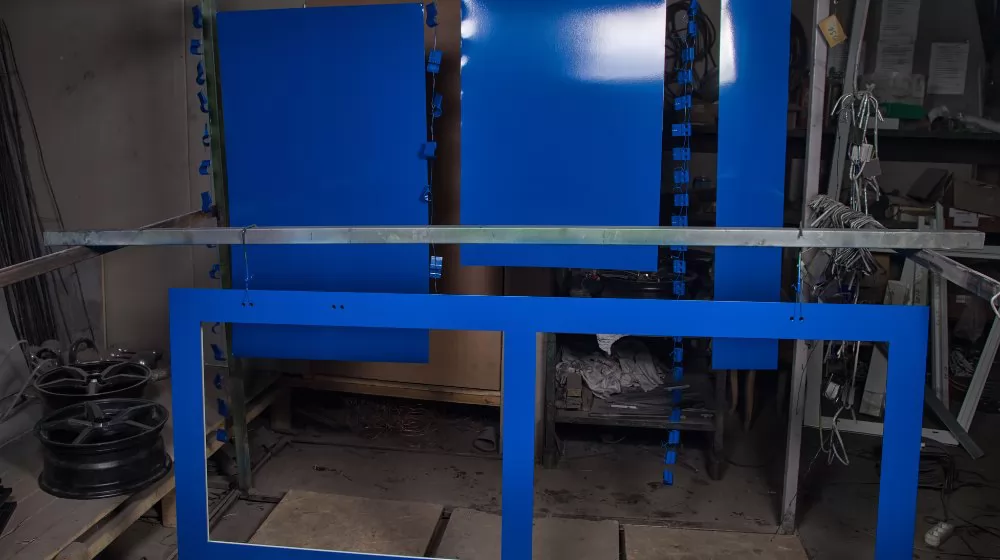
The reach of powder coating extends far beyond just a novel finishing technique. Its multifaceted benefits have rendered it indispensable across a spectrum of industries, from automotive to architecture and electronics. Here's how powder coating is revolutionizing these sectors:
The automotive industry, always at the forefront of innovation, was quick to adopt powder coating. With the challenges of wear and tear, exposure to various climatic conditions, and the need for dazzling aesthetics, the car manufacturing sector required a solution that was both durable and visually appealing.
Today, from luxury sedans to sporty convertibles, powder coating is the finish of choice for rims, bumpers, and other metal parts. This is largely due to its ability to provide a long-lasting finish that resists chipping, fading, and scratches far better than traditional paints. Furthermore, the array of colors and finishes available allows for customization that caters to the most discerning of tastes.
Modern architectural marvels aren’t just about unique designs; they're also about sustainability and durability. With urban structures being continuously exposed to environmental elements, there's a pressing need for finishes that can withstand the test of time.
Powder coating answers this call, especially for metal facades, railings, and structural components. Not only does it offer superior protection against rust and corrosion, but it also maintains its vibrancy, ensuring that buildings retain their aesthetic appeal for years to come. Moreover, with an increasing emphasis on green building standards, the environmentally-friendly nature of powder coating, which emits negligible VOCs, is an added boon for the architectural sector.
Electronics are an integral part of our daily lives, and as the lines between functionality and design blur, the electronics industry seeks finishes that are both protective and pleasing to the eye.
Powder coating serves this dual purpose. For products like computer casings, sound systems, and other consumer electronics, it provides a sleek finish that is resistant to scratches and general wear. Moreover, the absence of solvents in powder coating ensures that sensitive electronic components are not exposed to potentially harmful chemicals during the finishing process. The result? Durable electronic products that look as good as they perform.
In an ever-evolving industrial landscape, businesses are perpetually seeking ways to streamline operations, enhance product quality, and maximize profitability. Many companies, spanning various sectors, have realized the multifarious advantages of switching to powder coating. Here's a breakdown of how this move has catalyzed their success:
Transitioning to powder coating has proven economically savvy for numerous businesses. The process results in minimal waste, reducing costs related to material usage. Furthermore, since powder coating often requires fewer touch-ups and has an extended lifespan, maintenance and replacement expenses plummet.
Powder coating has ushered in a new standard of product quality. Items finished with this method showcase a uniform and sleek appearance, devoid of drips or runs. This boosts product appeal and, by extension, marketability.
In an era where businesses are held accountable for their environmental footprint, powder coating emerges as a frontrunner. With negligible VOC emissions and reduced waste, companies can not only champion eco-friendliness but also easily comply with stringent environmental regulations.
Thanks to the efficiency of the powder coating process and its rapid curing times, businesses can speed up production cycles. This means faster delivery times, leading to enhanced customer satisfaction and repeat business.
The myriad of finishes and colors available with powder coating allows businesses to diversify their product offerings. This capability can open new market segments and customer bases, promoting business expansion.
With the myriad advantages powder coating brings, it's evident that it stands as a pivotal choice for businesses and industries. Beyond just the technical benefits, the aesthetic transformation it delivers is unparalleled. As you chart the course for your next project, consider the lasting impact of a high-quality powder coat finish. And who better to guide you in this journey than Wintoly, a leading powder coating manufacturer known for its bespoke custom powder coating solutions? Dive into the world of elite finishes with Wintoly and ensure your project stands out in durability, appeal, and efficiency.
Read More:
1. What is powder coating?
2. What are the benefits of using powder coating?
3. What industries commonly utilize powder coating?
4. How do I choose a reliable powder coating supplier?
5. What types of powder coatings are available?
6. What is the typical minimum order quantity (MOQ) for powder coatings?
7. Can I request custom colors or formulations?
8. How do I ensure quality control when ordering powder coatings?
9. What are the typical curing requirements for powder coatings?
10. What are the payment terms typically offered by powder coating suppliers?
11. How can I request samples of powder coatings?
12. What should I consider when applying powder coatings?
When selecting a powder coating supplier, it’s essential to evaluate their product offerings, quality assurance processes, and customer service. Doing thorough research can help you find a supplier that meets your specific needs effectively.

 terrychen@wintoly.com
terrychen@wintoly.com
.png) 0086-757-85407388
0086-757-85407388
 6 Chaoyang Rd., National Demonstration Eco-industrialzone, Nanhai, Foshan,Guangdong,China
6 Chaoyang Rd., National Demonstration Eco-industrialzone, Nanhai, Foshan,Guangdong,China

.png)
